fischertechnik Pneumatics controlling SMC Robot Gripper. Find the latest News on robots drones AI robotic toys and gadgets at robots-blog.com. Follow us on our Blog Instagram Facebook Twitter or our other sites. Share your robotics ideas and products with us. #robots #robot #omgrobots #roboter #robotic #mycollection #collector #robotsblog #collection #botsofinstagram #bot #robotics #robotik #gadget #gadgets #toy #toys #drone #robotsofinstagram #instabots #photooftheday #picoftheday #followforfollow #instadaily #fischertechnik #smc #pneumatic #gripper
Archiv des Autors: Sebastian Trella
Revopoint POP 2 3D Scanner Launched on Kickstarter
The upgraded and even more feature-rich version of Kickstarter’s Most Funded 3D Scanner Ever was launched today
Shenzhen—Following its successful Kickstarter story with the platform’s most funded 3D scanner ever, Revopoint is launching today the second generation of the device, offering a new version that supports more functions and an enhanced 3D scanning performance. Catering to the requirements of 3D printing creators, VR/AR model makers, reverse design creators, and high-tech enthusiasts in general, Revopoint POP 2 3D Scanner has been launched at <https://bit.ly/30tcYiJ>.
POP 2 adopts a Binocular and Micro-Structured Light formula for an exceptionally high precision and texture scanning performance. The device uses a proprietary micro projecting chip to ensure that the fast acquired 3D point cloud data is captured with a high accuracy of 10 frame rates, achieving a 0.1mm single-frame accuracy.

POP 2 has a built-in high-performance 3D calculation chip that supports fast 3D scanning. Its embedded 6Dof Gyroscope also enhances a fluent shape, marker point and color feature point cloud stitching. „And the user can enjoy these amazing features with any ordinary smartphone, tablet, or laptop due to POP 2’s intelligent algorithms, which ensure speed and accuracy for the scanner regardless of the computer you use it with,“ Miss. Vivian, the co-founder of Revopoint, added.
The 3D scanner launched today allows users to explore expanded scanning possibilities, including using it as a handheld scanner for big statues and other big figures outdoors, or to mark points to scan large or featureless objects. POP 2 also innovates by using an invisible eye-friendly infrared light source to project and scan. This makes it possible for users to scan human and animal faces and body parts without producing any discomfort to the scanned subject.
„This is a professional-grade 3D scanner with a wealth of high-end features offered at a consumer-grade price. Everyone can buy it and use it,“ said Vivian. The versatile device supports high-precision handheld and turntable scanning, featuring impressive accuracy combined with a simplified one-button operation.
Designed for professionals and demanding hobbyists, POP 2 is a compact 3D scanner that can be carried and used anywhere. Its single cable can be used to charge and connect to the user’s smartphone, tablet, or laptop.
The scanner’s software is also simplified and user-friendly, allowing for the operation to be displayed on its interface. „If there’s an error, you can simply roll back, correct it, and keep moving forward with no worries,“ Vivian assured. The software works with Windows, Mac, Android and iOS, unlike conventional 3D scanner software, which only supports Windows.
The company representative further clarified that the device is especially designed for 3D printing, human body scanning, large-scale sculpture scanning, a plethora of cultural and creative design applications, reverse modeling, different medical applications, and advanced VR/AR and 3D modeling applications.
The Revopoint POP 2 3D Scanner campaign on Kickstarter at <https://bit.ly/30tcYiJ> is seeking to raise $9,975 to fund the large-scale production of the scanner. Backers who support the campaign gain early and discounted access to the device.
About Our Company
Revopoint focuses on the research and development of cutting-edge structured light and 3D imaging core hardware technology. The company’s core technical team leverages many years of experience in 3D imaging and artificial intelligence technology research and development, having developed different devices in the field, from chips to complete machines, focusing on 3D cameras and 3D scanner products.
KI ist mehr als nur ein Modell: Vier Schritte zum vollständigen Workflow-Erfolg
Ingenieur*innen sind zunehmend bestrebt, KI erfolgreich in Projekte und Anwendungen zu integrieren, während sie versuchen, ihre eigene KI-Lernkurve zu meistern. Allerdings werden viele KI-Projekte nach wenig vielversprechenden Ergebnissen wieder verworfen. Woran liegt das? Johanna Pingel, Product Marketing Manager bei MathWorks, erläutert, warum es für Ingenieur*innen wichtig ist, sich auf den gesamten KI-Workflow zu konzentrieren und nicht nur auf die Modellentwicklung:
Ingenieur*innen, die Machine Learning und Deep Learning einsetzen, erwarten oft, dass sie einen großen Teil ihrer Zeit mit der Entwicklung und Feinabstimmung von KI-Modellen verbringen. Die Modellierung ist zwar ein wichtiger Schritt im Workflow, aber das Modell ist nicht alleiniges Ziel. Das Schlüsselelement für den Erfolg bei der praktischen KI-Implementierung ist das frühzeitige Aufdecken von Problemen. Außerdem ist es wichtig zu wissen, auf welche Aspekte des Workflows man Zeit und Ressourcen konzentrieren sollte, um die besten Ergebnisse zu erzielen. Das sind nicht immer die offensichtlichsten Schritte.
Der KI-gesteuerte Workflow
Es lassen sich vier Schritte in einem KI-gesteuerten Workflow differenzieren, wobei jeder Schritt seine eigene Rolle bei der erfolgreichen Implementierung von KI in einem Projekt spielt.
Schritt 1: Datenaufbereitung
Die Datenaufbereitung ist wohl der wichtigste Schritt im KI-Workflow: Ohne robuste und genaue Daten zum Trainieren eines Modells sind Projekte rasch zum Scheitern verurteilt. Wenn Ingenieur*innen das Modell mit „schlechten“ Daten füttern, werden sie keine aufschlussreichen Ergebnisse erhalten – und wahrscheinlich viele Stunden damit verbringen, herauszufinden, warum das Modell nicht funktioniert.
Um ein Modell zu trainieren, sollten Ingenieur*innen mit sauberen, gelabelten Daten beginnen, und zwar mit so vielen wie möglich. Dies kann einer der zeitaufwendigsten Schritte des Workflows sein. Wenn Deep Learning-Modelle nicht wie erwartet funktionieren, konzentrieren sich viele darauf, wie man das Modell verbessern kann – durch das Optimieren von Parametern, die Feinabstimmung des Modells und mehrere Trainingsiterationen. Doch noch viel wichtiger ist die Aufbereitung und das korrekte Labeln der Eingabedaten. Das darf nicht vernachlässigt werden, um sicherzustellen, dass Daten korrekt vom Modell verstanden werden können.
Schritt 2: KI-Modellierung
Sobald die Daten sauber und richtig gelabelt sind, kann zur Modellierungsphase des Workflows übergegangen werden. Hierbei werden die Daten als Input verwendet und das Modell lernt aus diesen Daten. Das Ziel einer erfolgreichen Modellierungsphase ist die Erstellung eines robusten, genauen Modells, das intelligente Entscheidungen auf Basis der Daten treffen kann. Dies ist auch der Punkt, an dem Deep Learning, Machine Learning oder eine Kombination davon in den Arbeitsablauf einfließt. Hier entscheiden die Ingenieur*innen, welche Methoden das präziseste und robusteste Ergebnis hervorbringt.
Die KI-Modellierung ist ein iterativer Schritt innerhalb des gesamten Workflows, und Ingenieur*innen müssen die Änderungen, die sie während dieses Schrittes am Modell vornehmen, nachverfolgen können. Die Nachverfolgung von Änderungen und die Aufzeichnung von Trainingsiterationen mit Tools wie dem Experiment Manager von MathWorks sind entscheidend, da sie helfen die Parameter zu erklären, die zum genauesten Modell führen und reproduzierbare Ergebnisse liefern.
Schritt 3: Simulation und Tests
Ingenieur*innen müssen beachten, dass KI-Elemente meistens nur ein kleiner Teil eines größeren Systems sind. Sie müssen in allen Szenarien im Zusammenspiel mit anderen Teilen des Endprodukts korrekt funktionieren, einschließlich anderer Sensoren und Algorithmen wie Steuerung, Signalverarbeitung und Sensorfusion. Ein Beispiel ist hier ein Szenario für automatisiertes Fahren: Dabei handelt es sich nicht nur um ein System zur Erkennung von Objekten (Fußgänger*innen, Autos, Stoppschilder), sondern dieses System muss mit anderen Systemen zur Lokalisierung, Wegplanung, Steuerung und weiteren integriert werden. Simulationen und Genauigkeitstests sind der Schlüssel, um sicherzustellen, dass das KI-Modell richtig funktioniert und alles gut mit anderen Systemen harmoniert, bevor ein Modell in der realen Welt eingesetzt wird.
Um diesen Grad an Genauigkeit und Robustheit vor dem Einsatz zu erreichen, müssen Ingenieur*innen validieren, dass das Modell in jeder Situation so reagiert, wie es soll. Sie sollten sich auch mit den Fragen befassen, wie exakt das Modell insgesamt ist und ob alle Randfälle abgedeckt sind. Durch den Einsatz von Werkzeugen wie Simulink können Ingenieur*innen überprüfen, ob das Modell für alle erwarteten Anwendungsfälle wie gewünscht funktioniert, und so kosten- und zeitintensive Überarbeitungen vermeiden.
Schritt 4: Einsatz
Ist das Modell reif für die Bereitstellung, folgt als nächster Schritt der Einsatz auf der Zielhardware – mit anderen Worten, die Bereitstellung des Modells in der endgültigen Sprache, in der es implementiert werden soll. Das erfordert in der Regel, dass die Entwicklungsingenieur*innen ein implementierungsbereites Modell nutzen, um es in die vorgesehene Hardwareumgebung einzupassen.
Die vorgesehene Hardwareumgebung kann vom Desktop über die Cloud bis hin zu FPGAs reichen. Mithilfe von flexiblen Werkzeugen wie MATLAB kann der endgültige Code für alle Szenarien generiert werden. Das bietet Ingenieur*innen den Spielraum, ihr Modell in einer Vielzahl von Umgebungen einzusetzen, ohne den ursprünglichen Code neu schreiben zu müssen. Das Deployment eines Modells direkt auf einer GPU kann hier als Beispiel dienen: Die automatische Codegenerierung eliminiert Codierungsfehler, die durch eine manuelle Übersetzung entstehen könnten, und liefert hochoptimierten CUDA-Code, der effizient auf der GPU läuft.
Gemeinsam stärker
Ingenieur*innen müssen keine Datenwissenschaftler*innen oder gar KI-Expert*innen werden, um mit KI erfolgreich zu sein. Mit Werkzeugen für die Datenaufbereitung, Anwendungen zur Integration von KI in ihre Arbeitsabläufe und mit verfügbaren Expert*innen, die Fragen zur KI-Integration beantworten, können sie KI-Modelle auf Erfolgskurs bringen. In jedem dieser Schritte im Workflow haben Ingenieur*innen die Möglichkeit, flexibel ihr eigenes Domänenwissen einzubringen. Dies ist eine wichtige Basis, auf der sie mit den richtigen Ressourcen aufbauen und die sie durch KI ergänzen können.
Über MathWorks
MathWorks ist der führende Entwickler von Software für mathematische Berechnungen. MATLAB, die Programmiersprache für Ingenieurwesen und Wissenschaft, ist eine Programmierumgebung für die Algorithmen-Entwicklung, Analyse und Visualisierung von Daten sowie für numerische Berechnungen. Simulink ist eine Blockdiagramm-basierte Entwicklungsumgebung für die Simulation und das Model-Based Design von technischen Mehrdomänen-Systemen und Embedded Systemen. Ingenieure und Wissenschaftler weltweit setzen diese Produktfamilien ein, um die Forschung sowie Innovationen und Entwicklungen in der Automobilindustrie, der Luft- und Raumfahrt, der Elektronik, dem Finanzwesen, der Biotechnologie und weiteren Industriezweigen zu beschleunigen. MATLAB und Simulink sind zudem an Universitäten und Forschungsinstituten weltweit wichtige Lehr- und Forschungswerkzeuge. MathWorks wurde 1984 gegründet und beschäftigt mehr als 5000 Mitarbeiter in 16 Ländern. Der Hauptsitz des Unternehmens ist Natick, Massachusetts, in den USA. Lokale Niederlassungen in der D-A-CH-Region befinden sich in Aachen, München, Paderborn, Stuttgart und Bern. Weitere Informationen finden Sie unter mathworks.com.
Low-Cost-Portalroboter von igus in nur fünf Minuten online konfigurieren
drylin Portalkonfigurator senkt Hürde für den Einstieg in die Automatisierung
Köln, 16. November 2021 – In fünf Minuten einen Portalroboter online konfigurieren und programmieren, sofort den Preis erhalten, Funktionstests in der Augmented Reality durchführen und CAD-Daten mit technischer Zeichnung herunterladen: Das Alles macht der neue Portalkonfigurator von igus möglich. Angebunden an den Robotik-Marktplatz RBTX ist es durch ihn besonders einfach in die Welt der Low-Cost-Automation einzusteigen.
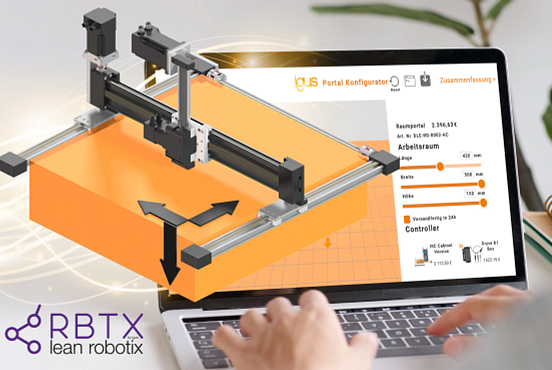
Mit dem neuen igus Online-Konfigurator lassen sich Linienportale, Flächenportale und Raumportale der drylin Serie konfigurieren. Es wird lediglich ein Browser mit Internetzugang benötigt. Von überall auf der Welt kann der Anwender dann ein Linienportal auswählen. Über virtuelle Schieberegler legt er die gewünschten Hublängen fest und sieht das 3D-Modell des Portals, das sich in Echtzeit den Schieberegler-Veränderungen anpasst, in einer 360-Grad-Ansicht von allen Seiten. Ebenso einfach kann der Nutzer das Portal um die passende Steuerung erweitern und erstellt so innerhalb von wenigen Minuten seine anschlussfertige Roboter-Lösung. Ein Festpreis, der sich dem Konfigurationsgeschehen ebenfalls in Echtzeit anpasst, ist sofort sichtbar. CAD-Modelle und Bemaßungszeichnungen stehen nach der Konfiguration direkt zum Download bereit. Darüber hinaus ist es möglich, den Roboter durch die Eingabe weniger Parameter auch zu programmieren. Als digitaler Zwilling visualisiert ein animiertes 3D-Modell dann die festgelegten Bewegungen. „Wir folgen mit dieser Funktion dem Motto ,Test-before-Invest‘“, sagt Alexander Mühlens, Leiter Geschäftsbereich Automatisierungstechnik und Robotik bei igus. „Bediener gewinnen dadurch online ein Gefühl für Roboterbewegungen und Taktzeiten. So kommen sie in der Realität schneller zu den gewünschten Ergebnissen, da sie die Hardware schon vor dem Kauf virtuell testen können.“
RBTX: Der Marktplatz für Low-Cost-Robotik
Der drylin Portalkonfigurator ist an den Low-Cost-Automation Marktplatz RBTX angebunden, auf dem verschiedenste Anbieter von Low-Cost-Robotik ihre Produkte und Kompetenzen bündeln. So finden sich hier nicht nur Linearroboter, sondern auch Scara-Roboter, Gelenkarmroboter und Deltaroboter. Kombinieren lassen sie sich mit Vision-Systemen, Gripper, GUIs, Motoren, Sensoren und Steuerung verschiedener Hersteller. Alle Komponenten, die im Konfigurator zur Verfügung stehen, wurden miteinander kombiniert und Kompatibilitätstests durchgeführt. Dadurch wissen Anwender bei jeder Konfiguration, dass sie auf der sicheren Seite sind. „Die Automatisierung entscheidet in immer mehr Branchen über die Wettbewerbsfähigkeit von Unternehmen. Mit dem neuen Portalkonfigurator gehen wir weiter in die Richtung, es auch kleinen Betrieben mit begrenzten Ressourcen zu ermöglichen, ohne hohen Kosten- und Zeitaufwand zu automatisieren“, fasst Alexander Mühlens zusammen. „Dieses Online-Tool ist ein erster Schritt, die auf RBTX befindlichen Produkte schon vor dem Kauf zu testen. Für die Zukunft denken wir an einen Konfigurator, mit dem sich vor jeglicher Investition alle Komponenten auf dem Marktplatz miteinander verheiraten und dann testen lassen.“
Probieren Sie den igus Portalkonfigurator unter https://www.igus.de/info/n21-portalkonfigurator aus.
Tactile Telerobot by Converge Reaches Finals of $10 Million ANA Avatar XPRIZE
Judges recognize the world’s first haptic robotic system to transmit realistic touch feedback to an operator located anywhere in the world
Converge Robotics Group reached the finals of the $10M ANA Avatar XPRIZE competition for an avatar system that can transport human dexterity to a remote location in real-time.
Converge Robotics Group is an international collaboration between Shadow Robot Company, HaptX, and Tangible Research responsible for developing the Tactile Telerobot, a high-fidelity dexterous telerobot in use in the U.S., U.K., and Asia, and now advanced to the ANA Avatar XPRIZE finals.

The Tactile Telerobot features Shadow Robot’s Dexterous Hands, HaptX Gloves DK2 with true-contact haptics, SynTouch’s biomimetic tactile sensors, and Universal Robots robotic arms to allow an operator to perform complex human tasks instantaneously across the globe such as handling objects in laboratories or workshops. The Tactile Telerobot mimics your movements, displaying human-like and reactive behaviours. Users can feel what the robot hands are touching, making it possible to connect humanity across vast distances like never before.
The groundbreaking technology of the Tactile Telerobot has been described as “weirdly natural” by Amazon founder Jeff Bezos, who added, “The tactile feedback is really tremendous.” The Telerobot’s most recent improvements for the XPRIZE Semifinals, hosted in Miami, include the use of high-fidelity audio and visual technology and other safety and usability improvements. It meets the competition’s criteria for a non-autonomous Avatar System with which an operator can see, hear, and interact within a remote environment in a manner that feels as if they are truly there.
Rich Walker, Managing Director of the Shadow Robot Company, said, “We’re coming up to Shadow’s 25th anniversary as a company and what a way to lead up to it by reaching the finals for a four-year global competition! The Shadow Dexterous Hands have been a sought-after product among the research community ever since we formally registered as a company. What the Hands can achieve today, on their own and as part of the Tactile Telerobot, is truly revolutionary and it’ll only get better.”
“Lifelike touch feedback is a critical component of transporting human presence,” said Jake Rubin, founder and CEO of HaptX. “The Tactile Telerobot demonstrates the difference that true-contact haptics makes in the field of robotic teleoperation, and we’re delighted for HaptX and our partners in Converge Robotics Group to receive this recognition from the ANA Avatar XPRIZE judges.”
“I’m proud of the accomplishments of our international and interdisciplinary team,” said Jeremy Fishel, founder and CTO of Tangible Research and Converge’s XPRIZE team lead. “We’ve brought together experts in robotic dexterity and haptics with the amazing technology of our partners and collaborators to do amazing things.”
In the XPRIZE Semifinals, the Converge Robotics Group debuted their collaboration with Voysys, a company that specialises in high-quality, low-latency video communication for the teleoperation of vehicles and machines.

„The combination of the Voysys video pipeline with ultra-low latency, the HaptX Gloves DK2, and the sensitive robot hand from Shadow Robot truly revolutionizes telepresence and makes remote working possible for a whole range of new industries,“ said Magnus Persson, CEO of Voysys.
“Advancing to the ANA Avatar XPRIZE finals alongside excellent competition is a significant milestone in this journey,” said the Converge Robotics Group in a statement “We look forward to showing how our Telerobot system can be used by ordinary people in amazing ways, making engineering jobs safer, reducing the need for global travel (and CO2 emissions) and letting us spend more time at home with our loved ones.”
Robotics Smarttech – mein erstes Mal fischertechnik
Auch wenn ich schon viele Roboter gebaut und getestet habe, ist dies heute eine Premiere! In den letzten Tagen habe ich zum ersten Mal einen Roboter von fischertechnik gebaut. Die Pressankündigung des fischertechnik Robotics Smarttech haben wir bereits in den letzten Tagen vorgestellt. [LINK]
Nun durfte ich ihn selber testen. Das Bausystem war mir zwar neu, hat mir aber auf Anhieb Spaß gemacht und ist wirklich einfach zu verwenden. Hat man sich einmal an die Bauanleitung und deren Stil gewöhnt, ist diese einfach verständlich. Während des Zusammenbaus des vierrädrigen Roboters mit den Omniwheels und dem Gestensensor, der mich ungefähr vier Stunden beschäftigt hat, habe ich dann auch gelernt auf welche Feinheiten ich in der Anleitung achten muss. Mir, als fischertechnik Neuling, sind zwei, drei Fehler passiert, die mir aber beim nächsten fischertechnik Modell bestimmt nicht mehr passieren würden. Überrascht war ich, dass man bei diesem Set die Kabel noch selber ablängen, abisolieren und die Steckverbinder anbringen muss. Das war ich aus anderem Roboter Kästen bisher nicht gewohnt; dies bietet aber die tolle Möglichkeit Kabel nach eigenen Wünschen und Längen zu erstellen. Diese Möglichkeit besteht bei vielen anderen Herstellern nicht und gerade wenn man mal einen etwas größeren Roboter baut, ist es von Vorteil wenn man lange Kabel selber fertigen kann.
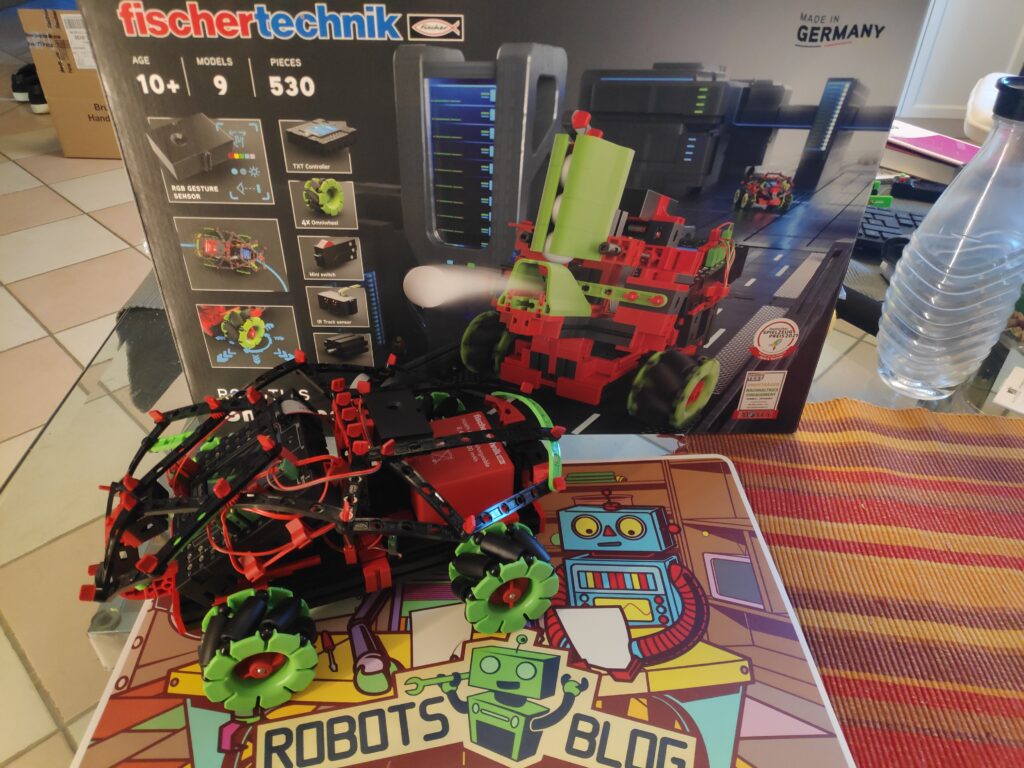
Die Bauteile halten gut zusammen und es lassen sich sehr stabile Roboter konstruieren. Kinder brauchen hier vielleicht an der ein oder anderen Stelle etwas Unterstützung wenn die Teile, gerade wenn sie noch neu sind, noch etwas schwergängig zusammen zu stecken sind. Der von mir gebaute Roboter war dafür im Anschluss sehr stabil und überlebt selbst kleinere Stürze ohne dass Teile abfallen.
Die coolen Omniwheels ermöglichen es dem Roboter jederzeit in jede Richtung zu fahren. Solche Räder findet man in Robotersets leider viel zu selten! Daher fiel die erste Wahl auch direkt auf das Basismodell mit den neuen Omniwheels. Anschließend habe ich dies mit dem Spursensor und dem Gestensensor erweitert. Neben diesen beiden Modellvarianten sind Anleitungen für weitere sieben Roboter enthalten.
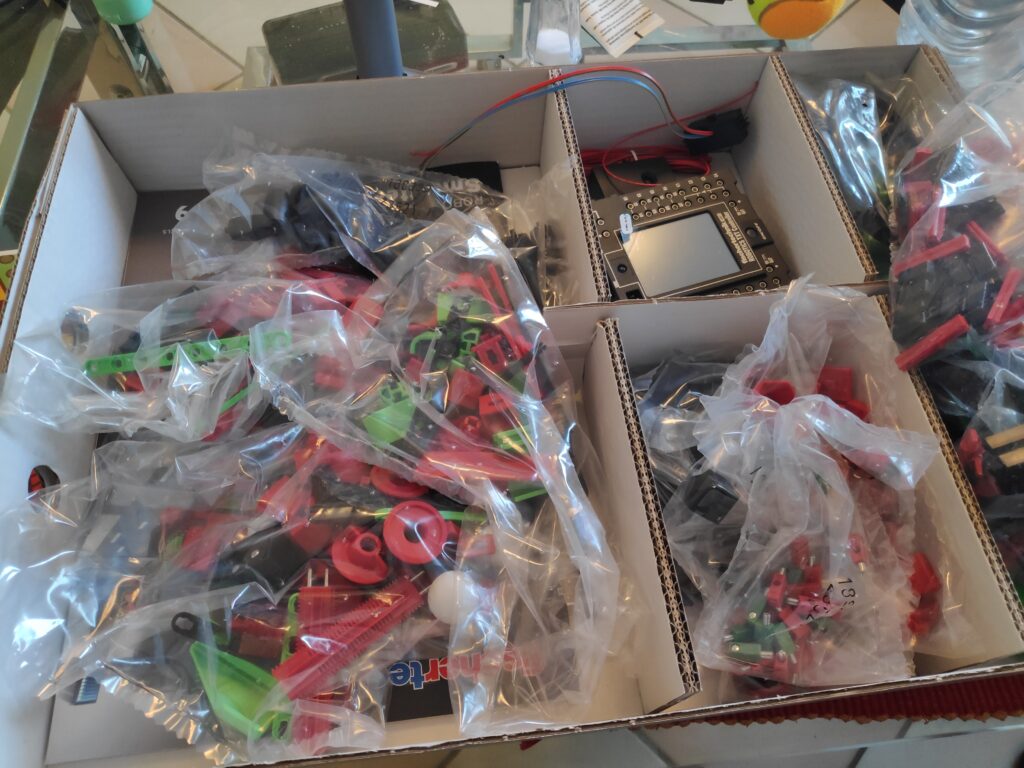
Der Roboter lässt sich entweder mit einem Netzteil oder mit einem Akku-Set betreiben, beides muss leider extra erworben werden.
Die aktuellste Version der für die Programmierung benötigten Software ROBOPro fand ich auf der Homepage von fischertechnik. Nachdem ich den Roboter über die Konfiguration auf dessen Touchscreen mit meinem WLAN verbunden habe (Okay: USB oder Bluetooth wäre auch gegangen, aber der Geek in mir musste direkt WLAN ausprobieren), konnte ich diesen mit der ROBOPro Software verbinden und programmieren. Das für die Cloud Funktionen benötigte Update wurde beim ersten Verbinden mit der ROBOPro Software mir sofort angeboten und ich konnte es problemlos installieren. Mit diesem Update lässt sich der Roboter als IoT Device in die fischertechnik Cloud einbinden und als smartes Gerät mit dem Internet kommunizieren. So kann man zum Beispiel eine Alarmanlage bauen, die einen über das Internet beim Auslösen alarmiert.
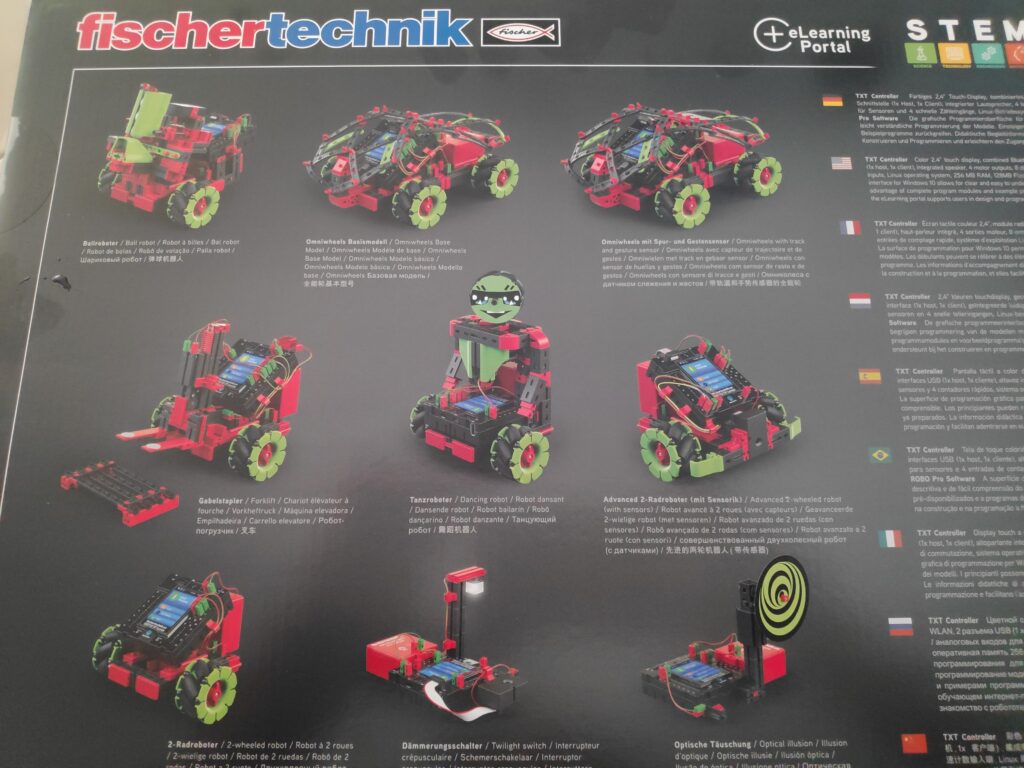
Neben der Möglichkeit in der ROBOPro Software grafisch zu programmieren, kann mit einer zusätzlichen frei verfügbaren Software auch in Scratch grafisch programmiert werden. Wer lieber textbasiert programmieren möchte kann dies auch in C. Da das Betriebssystem des Roboters auf Linux basiert, gibt es hier bestimmt noch jede Menge weitere, mir bisher unbekannte, Möglichkeiten den Roboter zu „hacken“ und noch mehr Funktionen hinzuzufügen. Das Einloggen auf dem Roboter per SSH ist auf jeden Fall möglich und über den SD-Karten Slot lassen sich alternative Betriebssysteme installieren und der Speicher erweitern.
Mein erster fischertechnik Roboter, genauer der Robotics Smarttech Roboter, hat mir bisher Freude bereitet und ich hatte Spaß daran mal ein mir bisher unbekannte Bausystem auszuprobieren. Mit den „selbstgebauten“ Kabeln und den universellen Ei- und Ausgängen am Controller, sowie der Cloud Anbindung, finden sich sicherlich auch tolle Einsatzmöglichkeiten abseits vom Einsatz als Spielzeugroboter.
MAKER LEARN FESTIVAL
FREE E-LEARNING ARRIVES TO YOUR HOME OR OFFICE FROM 8 TO 12 NOVEMBER BY MAKER FAIRE ROME

Over 50 webinars, talks, online and free workshops about all the innovation topics offered by our makers and partners: check out the complete list of webinars and choose the one that suits you the most!
Participating is simple: you just need to register for the event of your choosing and then you will receive an alert just before it starts. All webinars are held on Zoom: make sure you got the app on your device.
MAKER LEARN FESTIVAL: E-LEARNING FOR EVERYBODY
Maker Learn Festival is truly for everyone.
A few examples? If you are a professional, an entrepreneur, a startupper, take look at the webinars dedicated to the world of entrepreneurship with specific focus on digital and robotics, artificial intelligence, digital manufacturing and 3D printing, transition 4.0, PNRR and incentives for SMEs . Eg check the selection for the fabrication topic here.
And that’s not all, an entire section is dedicated to innovation born within the Italian universities and there is no shortage of webinars and specific workshops for students and young people!
„Academic“ events: select the „Universities“ tag and discover all the workshops and talks organized by some of the most important Italian universities, including the University of Pisa, La Sapienza University of Rome, the University of Studies Roma Tre, the Polytechnic of Bari.
Appointments for students and teenagers: dedicated contents from robotics to experiments to be done in the classroom or at home along with the parents.
And if you want to, you can specifically select the topics of your interest, browse by topics such as art, robotics, artificial intelligence … the offer is very wide!
Come and discover all the innovation you need on the Maker Learn Festival, from 8 to 12 November!
WHAT IS MAKER LEARN FESTIVAL
Maker Learn is the project of Maker Faire Rome and PID Punto Impresa Digitale, for continuous training, a web gateway in which you can find free training opportunities throughout the year covering the most diverse topics. Maker Learn Festival is the natural continuation of Maker Faire Rome, the event that was held from 8 to 10 October. With Maker Learn Festival we celebrate the continuous training by concentrating over 50 different courses in one week. By participating in the Maker Learn Festival, you can experience firsthand the benefits that “life long learning” can offer you.
Fraunhofer IAIS und Dr. Hans Riegel-Stiftung realisieren erste 3D-Simulation zu Roboter-Programmierungen im Open Roberta Lab
Seit rund vier Jahren arbeiten das Fraunhofer-Institut für Intelligente Analyse- und Informations-systeme IAIS und die Dr. Hans Riegel-Stiftung im Rahmen ihrer Projekte »Open Roberta®« und »TouchTomorrow« zusammen, um junge Menschen für Coding & Co. zu begeistern. Das jüngste Ergebnis der Zusammenarbeit ist die erste 3D-Simulation des humanoiden Roboters NAO für die Open-Source-Plattform »Open Roberta Lab«. NAO ist mit Anschaffungskosten von mehreren tausend Euro im Vergleich zu anderen Mikrocontrollern und Hardware-Systemen wie Calliope mini oder LEGO Mindstorms sehr teuer und deshalb in Privathaushalten oder auch in Schulen kaum vertreten. Ab sofort haben Open-Roberta-Fans die Möglichkeit, die anschaulichen Programmiermöglichkeiten des NAO in einer 3D-Simulation auszuprobieren und zu erlernen. Schon jetzt ist das Open Roberta Lab in mehr als 20 Sprachen verfügbar und wird in über 100 Ländern von ca. 500 000 Personen pro Monat genutzt – mit dem 3D-Roboter steigt die Attraktivität der Programmierplattform um ein weiteres Highlight.
Das »Open Roberta Lab« ist eine frei verfügbare grafische Programmierplattform, die das Programmieren lernen leicht macht. Auf der Open-Source-Plattform der Initiative »Roberta® – Lernen mit Robotern« des Fraunhofer IAIS erstellen selbst Neulinge im Handumdrehen erste Programme per »drag and drop«. Die Besonderheit: Im Open Roberta Lab erwachen reale Roboter und Mikrocontroller zum Leben. »Hands-on« erlernen Nachwuchs-Programmiererinnen und -Programmierer die Grundlagen des Codens und entdecken spielerisch die unzähligen Möglichkeiten, die die Welt der Technik und Naturwissenschaften für sie bereithält.
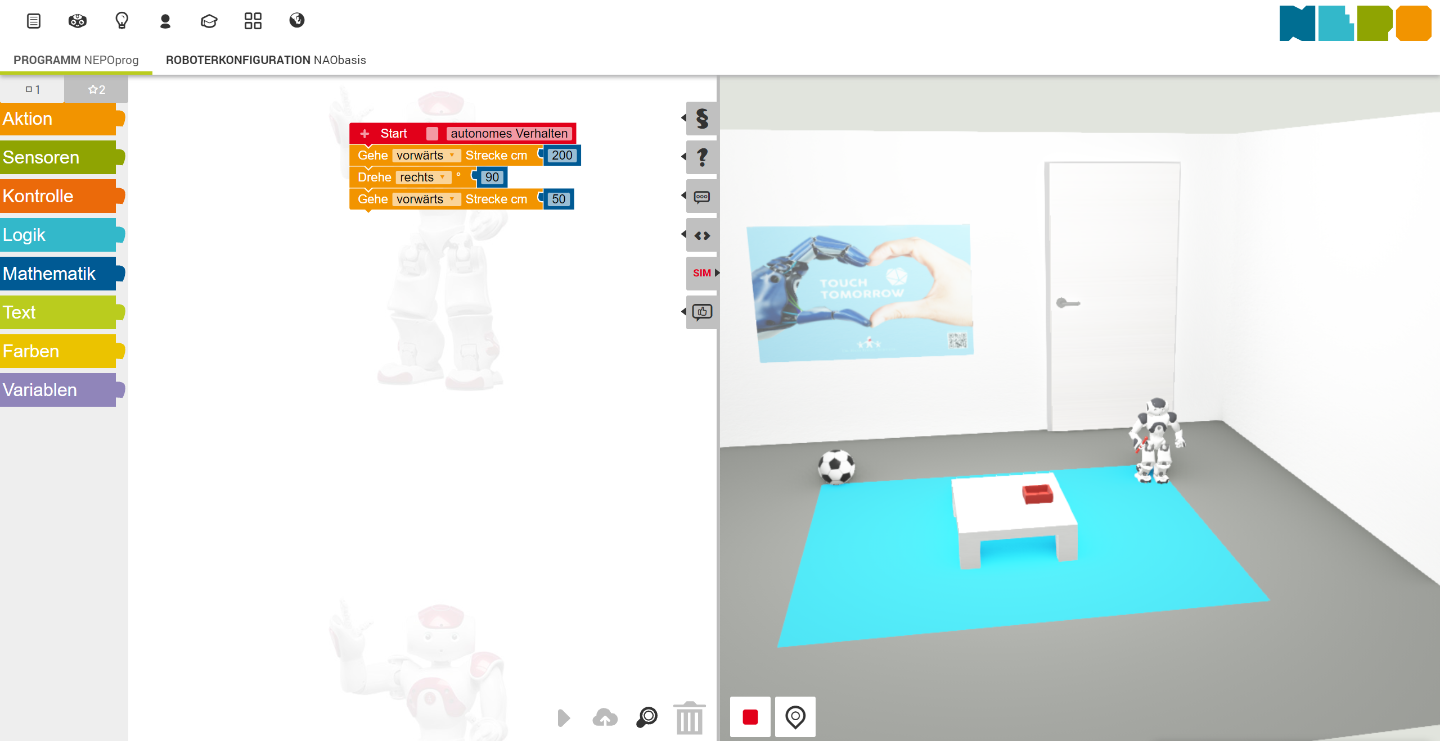
Unter den aktuell 14 Roboter- und Hardware-Systemen, die im Open Roberta Lab programmiert werden können, ist der humanoide Roboter NAO mit seinen 25 Bewegungsgraden, umfangreicher Sensorik und einem Kaufpreis von mehr als 5000 Euro die komplexeste und teuerste Variante. Gleichzeitig ist es natürlich besonders spannend, einen humanoiden Roboter programmieren zu können. Aus diesem Grund haben das Fraunhofer IAIS und Dr. Hans Riegel-Stiftung nun eine erste 3D-Simulation für die Plattform integriert, so dass sich die Nutzer*innen auch ohne teure Hardware die Resultate ihrer Programmierungen in einer detaillierten Simulation anschauen können. Dies soll u. a. zusätzliche Erfolgserlebnisse ermöglichen und damit die Motivation steigern.
Das erste Tutorial mit 3D-Simulation steht ab sofort auf https://lab.open-roberta.org/ zur Verfügung.
Weitere Kooperationen von Fraunhofer IAIS und Dr. Hans Riegel-Stiftung
Begonnen hat die Zusammenarbeit im Rahmen der Entwicklung des »TouchTomorrow-Trucks« der Dr. Hans Riegel-Stiftung, der bundesweit an Schulen fährt, um Schülerinnen und Schüler durch das Erleben und Ausprobieren von Zukunftstechnologien für Bildungs- und Berufswege im MINT-Bereich (Mathematik, Informatik, Naturwissenschaft, Technik) zu begeistern. Eine von acht Themenstationen im Truck befasst sich mit humanoiden Robotern. Schülerinnen und Schüler können dort dank mehrerer vom Fraunhofer IAIS entwickelter Tutorials einen echten NAO-Roboter programmieren. Neben dem Truck sind in den vergangenen Jahren weitere Angebote entstanden: u. a. »TouchTomorrow-Teaching« mit Unterrichtsmaterial und Fortbildungen für Lehrkräfte, »TouchTomorrow-Stream« als Livestream-Dialogformat für Distanz-Lehranlässe wie Covid-19 und das »TouchTomorrow-Lab« im Deutschen Museum Bonn.
Das Deutsche Museum Bonn ist einer von fünf »Open Roberta Coding Hubs« in NRW. Dies sind außerschulische Lernorte, die mit Hardware wie Robotern und Laptops ausgestattet und deren Personal vom Roberta-Team des Fraunhofer IAIS vor Ort zu Roberta-Teachern ausgebildet werden. Das TouchTomorrow-Lab im Deutschen Museum Bonn bietet eine ideale Kulisse für die diversen Workshops in diesem Kontext.
Beate Jost, Technische Leiterin der Roberta-Initiative und Wissenschaftlerin am Fraunhofer IAIS: »Wir freuen uns, dass unsere langjährige Kooperation mit der Dr. Hans Riegel-Stiftung nun in eine neue Phase geht. Mit der neuen NAO-Simulation haben Programmier-Fans und vor allem Schulen ab sofort die Gelegenheit, spannende Experimente mit humanoiden Robotern auszuprobieren, ohne dafür gleich tief in die Geldbörse greifen zu müssen.«
Omniwheels-Fahrzeuge und Tanzroboter – fischertechnik Baukasten für Robotics-Einsteiger
Mit dem Baukasten Robotics Smarttech (249,90 Euro, erhältlich ab August) steigt fischertechnik in die nächste Dimension der fahrbaren Roboter ein. Mit neuen Bauteilen lassen sich verschiedene Omniwheels-Fahrzeuge konstruieren, die sich in sämtliche Richtungen bewegen können. Auch weitere Modelle, wie ein Tanzroboter, lassen sich mit dem Baukasten für Robotics-Einsteiger bauen und programmieren. Im Baukasten enthalten sind der TXT Controller und die Software ROBO Pro.
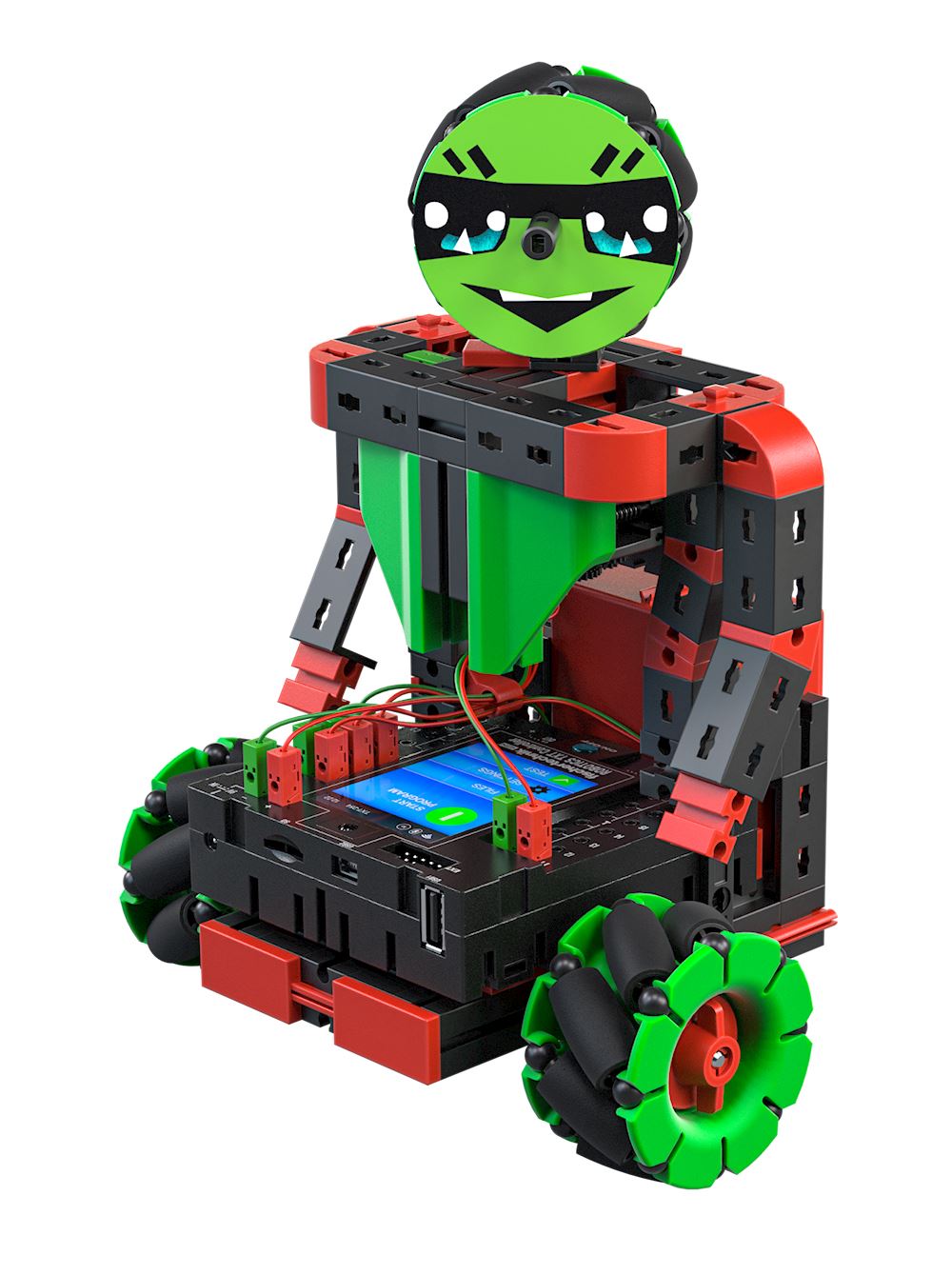
Der Baukasten Robotics Smarttech ermöglicht einen Einblick in die Zukunft autonom fahrender Fahrzeuge. Der enthaltene RGB-Gestensensor erkennt Gesten in vier verschiedenen Richtungen, misst RGB-Farbwerte und Umgebungshelligkeit, kann als Näherungssensor eingesetzt werden und misst hierbei Abstände von bis zu 15 Zentimetern. Zusammen mit dem IR-Spursensor und dem Taster lassen sich so verschiedene spannende Fahrroboter bauen und programmieren, die darauf warten, von jungen Tüftlern und Entwicklern auf Erkundungstour geschickt zu werden.
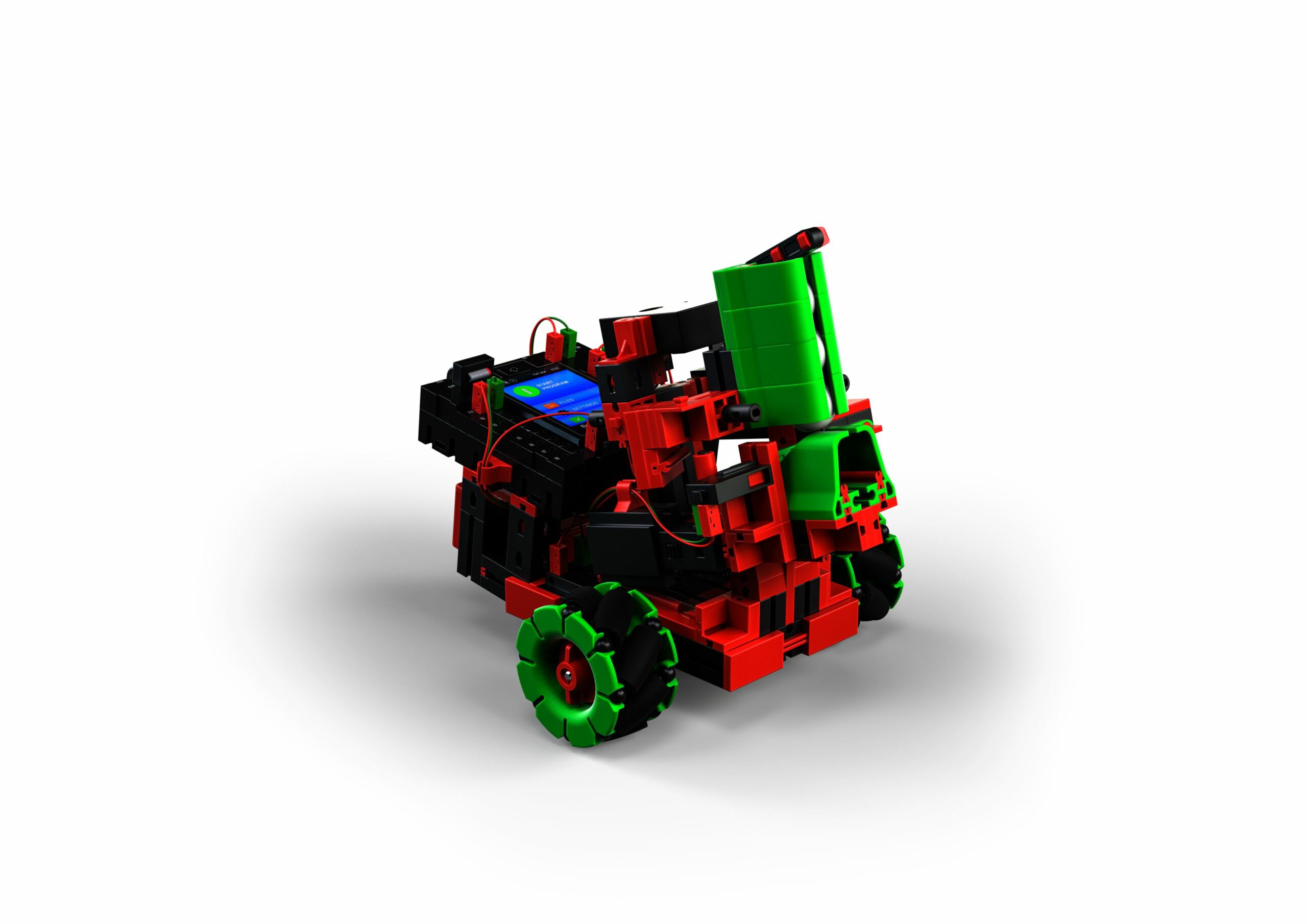
Die Fahrzeuge sind mit einem komplett neuen Räderkonzept ausgestattet, wie es in der mobilen Robotik vorkommt. Die Omniwheels – oder Allseitenräder – ermöglichen ein platzsparendes Rangieren, indem die Fahrzeige seitlich oder diagonal fahren. Außerdem können sich die Fahrzeuge sogar auf der Stelle drehen. fischertechnik entwickelte hierfür extra belastbare, qualitativ hochwertige Bauteile, um die Funktionalität der vielseitigen Fahrzeuge gewährleisten zu können.
Ein weiteres attraktives Modell ist der Tanzroboter, der – einmal zusammengebaut und programmiert – lustige Bewegungen und Drehungen vollziehen kann.
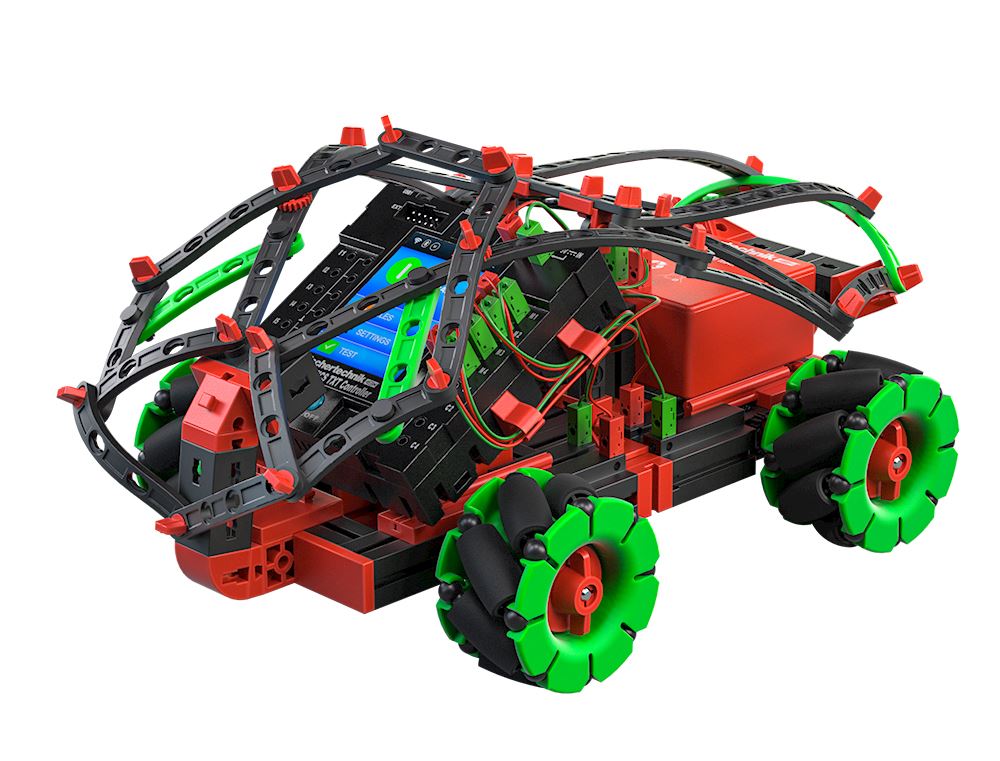
Bevor diese anspruchsvolleren Modelle gebaut werden, können sich Anfänger an einfachen Konstruktionen versuchen. Das Demo-Modell erklärt das Grundprinzip, wie Motor und Taster programmiert und gesteuert werden können. Per Knopfdruck läuft der Motor für eine zuvor definierte Zeit, währenddessen bewegt sich eine Drehschreibe mit einer Grafik, die eine optische Täuschung hervorruft. Erfahrene Konstrukteure wagen sich an einen fahrbaren Roboter, mit dem verschiedene Fahraufgaben programmiert werden können.
Insgesamt können mit dem Baukasten neun verschiedene Robotics-Modelle gebaut und programmiert werden. Der Baukasten ist für Kinder ab 10 Jahren geeignet.
